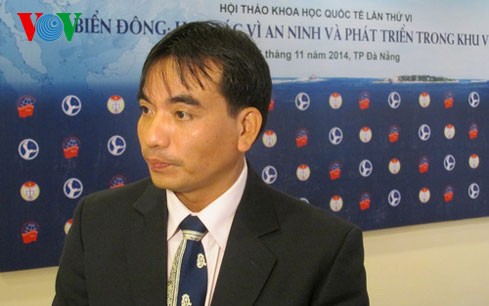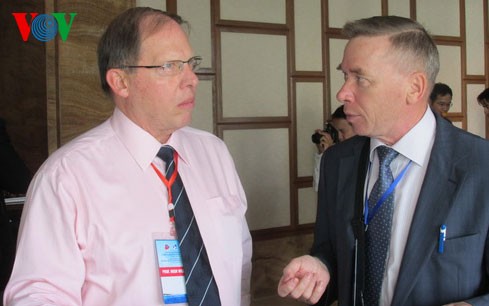China can’t change Vietnam’s EEZ in the East Sea
Thanh Ha-VOV correspondent in Da Nang -
(VOVworld) – Delegates discussed international relations and order in the East Sea and international law: seas and skies during the second day of the ongoing international workshop on the East Sea in Da Nang. They agreed that there had been 4 elements affecting the situation in the East Sea recently. They included a change in the calculations of a number of countries concerning the strategic interests of all parties, the increase of nationalism in some dispute countries, the competition for influence and rallying of force among world powers, and the differences in interpreting and applying international law, including the 1982 UN Convention on the Law of the Sea in the East Sea. Many delegates agreed that the increase in the number and intensity of activities by paramilitary forces and law enforcement agencies in the East Sea was one of the reasons for tensions in this region. Notably, China’s large-scale expansion and build-up at shoals in Truong Sa have changed the status quo in the East Sea.
 |
Doctor Hoang Viet from the Ho Chi Minh city University of Law is a researcher of the East Sea: “Many geographical structures in Hoang Sa and Truong Sa are shoals but China calls them islands and that if inhabited these islands will have exclusive economic zones and continental shelves. If China manages to transform these shoals, they would have aircraft carriers and their ambition of controlling the East Sea would be considerably strengthened. China could also potentially announce an air-defense identification zone in Truong Sa and the East Sea.”
 |
While disputes remain unresolved, countries have begun to use artificial islands through which to further complicate the situation. Nguyen Thi Lan Anh, Deputy head of the Institute for East Sea Studies at Vietnam’s Foreign Ministry, said artificial islands have a maximum safety zone of only 500 meters. Professor Kuan Hsiung Dustin Wang from the National Taiwan University said China would turn these artificial islands into shelters at sea. But according to Doctor James Charles Kraska from the Stockton International Law Research Center at the US Naval War College, although China had illegally occupied Hoang Sa archipelago and issued its illegal 9-dotted line claim, Vietnam’s legitimate rights over its Exclusive Economic Zone would remain unchanged.
The 6th international conference on the East Sea concluded in Da Nang city on Tuesday. Delegates discussed East Sea issues in international relations, East Sea claims and maritime disputes, and regulations on the territories, seas and skies in international law. They said that measures to build trust and preventative diplomacy were needed to control conflicts in the East Sea, adding that all parties should exercise self-restraint and not conduct unilateral acts that change the status quo in the area. Any efforts to turn shoals into military bases in disputed areas or to establish air-defense identification zones would run counter to international law and complicate the situation. In his closing speech, Director of the Vietnam Diplomatic Academy Dang Dinh Quy said maintaining the status quo and exercising self restraint were crucial and effective measures to control conflicts in the East Sea.
Thanh Ha-VOV correspondent in Da Nang